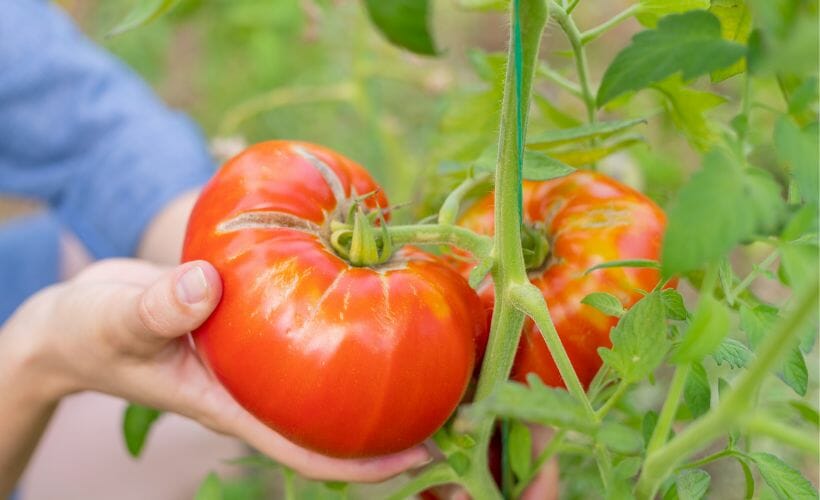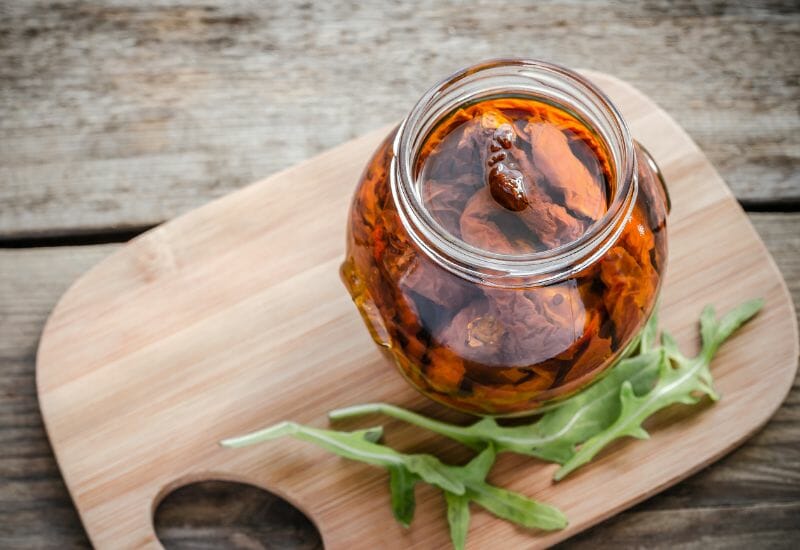The Best Time to Pick Tomatoes + Simple Ways to Preserve Them
Not sure when your tomatoes are ripe? Learn how to tell when they’re ready to pick and discover simple ways to preserve every last one.

There’s something magical about growing your own tomatoes. That first warm bite of a sun-ripened tomato—juicy, sweet, and just a little tangy—is what keeps so many of us planting them year after year. But if you’ve ever picked a tomato that was mealy, under-ripe, or split open on the vine, you know that timing matters.
So when is the best time to pick tomatoes?
Let’s walk through how to spot that perfect harvest moment—and what you can do with your tomatoes after picking so not a single one goes to waste.
How to Tell When Tomatoes Are Ready to Harvest
Tomatoes don’t come with a little light that blinks “I’m ripe!”—but they do give you clear signs if you know what to look for. Here’s how I tell when it’s time to harvest:
Check the Color (But Know Your Variety)
For most red tomato types, you’re looking for a rich, even color across the entire fruit. No green shoulders, no streaks. But keep in mind:
- Yellow tomatoes should be fully golden
- Black/purple varieties like Cherokee Purple develop a dusky, deep color
- Striped or speckled heirlooms (like Green Zebra) might never look “traditional” ripe
Whatever the color, the key is consistency and vibrancy.
Give It a Gentle Squeeze
Ripe tomatoes should feel firm but have a little give when you press gently with your thumb. If it’s rock hard, it’s not ready. If it feels squishy or soft, it’s likely overripe.
Pay Attention to Size
This one’s trickier since tomato sizes vary wildly. But once your variety reaches its mature size and the color and texture are on point, it’s time to harvest.
Test the Pull
Tomatoes that are ready usually separate easily from the vine with a gentle tug. If you have to wrestle it off, give it another day.

Can You Pick Tomatoes While They’re Still Green?
Yes—and in some cases, you should.
If you’ve got heirlooms or beefsteak tomatoes that are prone to splitting or falling off the vine before ripening, it’s smart to pick them at the mature green stage—meaning they’ve reached full size and have a hint of their ripe color, but haven’t fully turned yet.
Bring them inside to finish ripening on a sunny windowsill. Place them stem side down to avoid bruising, and if you want to speed things up, pop a ripe banana nearby. The ethylene gas helps ripen tomatoes faster.
This is especially helpful toward the end of the season when the nights get chilly and you’re racing against the first frost.
Tip: Tomatoes ripened indoors won’t be quite as sweet as vine-ripened ones—but they’ll still beat anything from the store.
A Few Common Signs It’s Too Late to Pick
Sometimes we wait too long. Here’s what that might look like:
- Cracked skin: Usually from overwatering or heavy rain after a dry spell
- Soft spots: Means it’s starting to rot
- Wrinkled skin: It’s past its prime but still salvageable for sauce
- Fruit drop: If tomatoes are falling off the vine on their own, they’re definitely ready (or overripe)
Try to check your plants daily once they start ripening—it’s amazing how fast they can go from “almost there” to “why is this mushy?”
Simple Ways to Preserve Your Tomato Harvest
If your kitchen counter is overflowing with tomatoes (lucky you!), here are some tried-and-true ways to keep enjoying them long after summer ends.
Roast and Freeze for Easy Dinners
Roasted tomatoes are one of my secret weapons. Cut them into wedges, toss with olive oil, garlic, and herbs, then roast at 375°F until caramelized and soft. Let them cool, then freeze in portions.
Need to peel your tomatoes before roasting? Skip the boiling water and ice bath. Here’s a quick trick for peeling tomatoes without any fuss—it’s my go-to method during peak harvest time.
They’re perfect for:
- Tossing into pasta
- Blending into soup
- Spreading on sandwiches
Try Your Hand at Canning
Whether it’s crushed tomatoes, salsa, or sauce, water bath canning is a great way to lock in flavor. Just be sure to follow safe canning procedures. If you’re new to it, here’s my Water Bath Canning FAQs post to get you started.
Canned tomatoes are:
- Shelf-stable
- Ready for winter stews
- A budget-saver when grocery prices rise
If you’re ready to fill your pantry with tomato goodness, try making your own flavor-packed tomato paste for a rich base that elevates everything from soups to stews. Or go all-in with a homemade spaghetti sauce that puts store-bought jars to shame—perfect for busy weeknights or slow Sunday dinners.
Make Tomato Jam or Preserves
Tomato preserves might sound fancy, but they’re actually simple and so good. Think of it like a sweet and savory spread for toast, burgers, or grilled cheese.
To get started, check out this easy tomato jam recipe I recommend.

Store in Oil (With Caution)
Slow-roasted tomato halves packed in olive oil with garlic and herbs are a flavor bomb—but they must be refrigerated and used quickly for food safety.
If you try this method:
- Use sterilized jars
- Keep the tomatoes submerged in oil
- Store in the fridge for up to a week
Ripe, Ready, or Not? FAQs Answered
Save these tomato tips to make harvest season easier.

Harvesting tomatoes isn’t just about timing—it’s about tuning into your garden and knowing when your fruit is at its peak. A little patience goes a long way, and with the right knowledge, you’ll never have to second-guess yourself again.
And once those tomatoes are picked? Make sure your hard work doesn’t go to waste. Whether you freeze, can, roast, or eat them fresh with salt (my personal favorite), every bite is a reminder that you grew this.
What’s your favorite way to use up garden-fresh tomatoes? Share your go-to recipe or preservation tip in the comments—I’d love to hear it!
